In the process of building a shooting range, perhaps the most intimidating part is getting it approved by your local government. Even after you’ve done all the work, raised all the money, and planned everything out, the final say still comes down to a handful of elected officials. Don’t let that make you feel powerless, though. Even if the ultimate decision is in someone else’s hands, there are still things you can do to increase your chances of success.
1) Talk to the Right People
Your local government officials need to know as soon as possible that you’re planning to build a shooting range. They’ll appreciate it if you inform them early and often of your intentions, and that communication can open doors for you later on. You’ll have a much better chance of getting your range approved if you’ve established a relationship with local leaders from the beginning.
Early communication will also help you figure out zoning issues. In most cases, land has to be zoned as either commercial or industrial for a shooting range to be built on it. Find out first thing if the land you’re looking at is zoned appropriately. Zoning requirements for building a shooting range vary depending on where you live, and some places may not even have specific guidelines for ranges. Your local officials will have the most accurate information and can help you understand the requirements. Should you discover that the land you plan to build on is not zoned appropriately for a shooting range, ask the planning and zoning committee if it can be re-zoned. Often, city governments are willing to work with local businesses on zoning issues to keep potential commerce from going elsewhere.
2) Educate Yourself
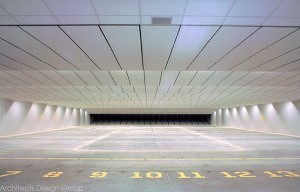 The more you know about what’s required to get your range approved, the better. Become familiar with local noise and firearms regulations as well as environmental restrictions that will apply to your shooting range. How will you handle noise abatement? How will you dispose of lead? How will you keep customers and employees safe? All of these issues will come up when presenting to the city council. If you already know what their concerns are by asking questions and doing research, you can adequately prepare to answer them.
The more you know about what’s required to get your range approved, the better. Become familiar with local noise and firearms regulations as well as environmental restrictions that will apply to your shooting range. How will you handle noise abatement? How will you dispose of lead? How will you keep customers and employees safe? All of these issues will come up when presenting to the city council. If you already know what their concerns are by asking questions and doing research, you can adequately prepare to answer them.
Once you know what standards you’re shooting range will be required to meet, talk to an Action Target territory manager to find out what options are available. Action Target specializes in building state-of-the-art shooting ranges and offers several technologies to meet the stringent requirements of government regulations. For example, Action Target’s Total Containment Trap (TCT) is the most environmentally-friendly bullet trap in the industry and makes lead containment safe and easy. With the addition of a Screw Conveyor System (SCS), all bullets and range debris are safely collected and deposited into a sealed barrel for convenient disposal. Action Target also provides sound-abating safety baffles, acoustically-rated wall systems that reduce reverberation by 98%, bullet-proof transparent lane dividers, and ventilation systems that filter air and protect customers from lead exposure. No matter what regulation your shooting range is under, chances are Action Target has a patented technology to meet it.
3) Prepare to Present
Once you’ve talked to your local government officials and learned everything you need to know about regulations and restrictions, all that’s left to do is present your plan to the city council. For those inexperienced in public speaking, this may be the scariest part of the whole process. To make the experience smoother, ask a city council member in advance what information they want from you, write down a list of questions they may ask you, and prepare all of your answers ahead of time so you don’t forget in the heat of the moment.
If you feel like you need additional backup, Action Target representatives are more than willing to attend the city council meeting with you no matter where you live. That way you can have a shooting range expert standing next to you to answer any questions about the technology and safety features of your future range.
The sales team at Action Target is willing to do whatever it can to make the approval process as seamless and successful as possible for you. If you have any questions or concerns about getting your shooting range approved, call Action Target at (801) 377-8033 and ask to speak with your area representative.
And be sure to check out our Build Your Range tool by clicking here.
Please note, the tips included in this message have been found to be helpful for many clients throughout the years, but may not apply in all situations. Please use judgment in determining which tips will be helpful in your particular situation.
This article was originally published in the Action Target Journal on June 14, 2012.







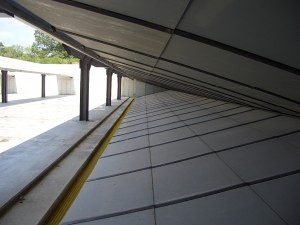
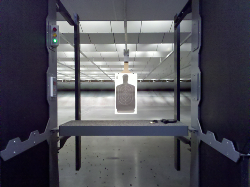 different portable systems to meet your budget and needs, running targets can easily be incorporated into your training program. The Track Runner provides the tools for a wide variety of situation with single or double track configurations, cardboard and steel target compatibility, variable speed and electric braking, and remote hand held control of movement.
different portable systems to meet your budget and needs, running targets can easily be incorporated into your training program. The Track Runner provides the tools for a wide variety of situation with single or double track configurations, cardboard and steel target compatibility, variable speed and electric braking, and remote hand held control of movement.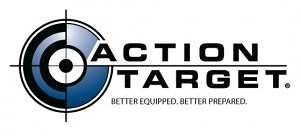 There are hundreds of things to take into consideration when building a shooting range, but your top priority should always be safety. Before anything else, make sure your range is going to be safe for your customers, your employees, and the environment. If you are considering building a range, talk to the
There are hundreds of things to take into consideration when building a shooting range, but your top priority should always be safety. Before anything else, make sure your range is going to be safe for your customers, your employees, and the environment. If you are considering building a range, talk to the  The Action Target Total Containment Trap can be a great solution to this problem if your daily foot traffic is able to balance the expense of installing and maintaining it. With two different types of lead removal systems, the TCT allows for varying levels of use and greatly diminishes the time you have to spend maintaining your shooting range. Essentially, the TCT is a giant armor steel
The Action Target Total Containment Trap can be a great solution to this problem if your daily foot traffic is able to balance the expense of installing and maintaining it. With two different types of lead removal systems, the TCT allows for varying levels of use and greatly diminishes the time you have to spend maintaining your shooting range. Essentially, the TCT is a giant armor steel 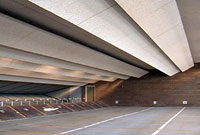 Action Target’s patented wall and ceiling baffles are designed to
Action Target’s patented wall and ceiling baffles are designed to 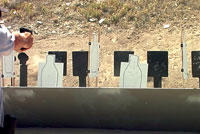
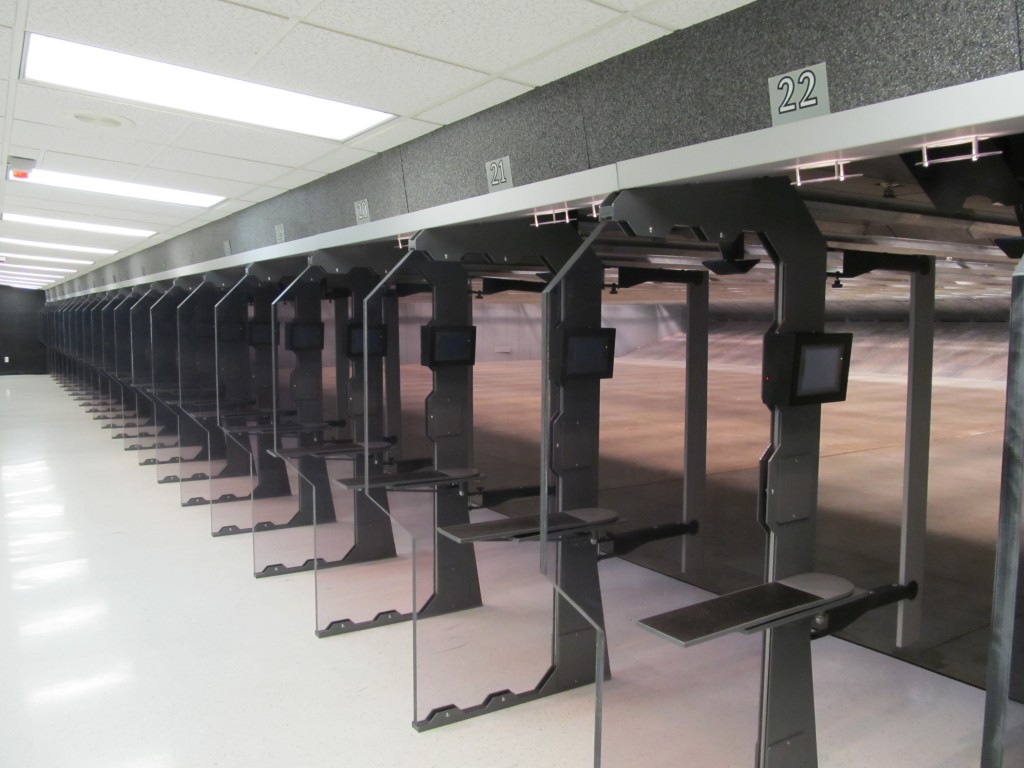 Because
Because 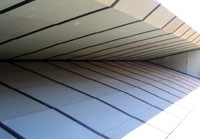 The equipment you install in your shooting range can also have a significant effect on your future success. If you anticipate a large number of shooters on your range every day, you may want to reconsider the
The equipment you install in your shooting range can also have a significant effect on your future success. If you anticipate a large number of shooters on your range every day, you may want to reconsider the 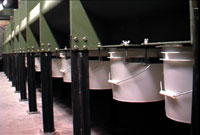 Time is money. The more time the range is shut down for service, the less money the range is making. In other words, each time a range has to shut down should be viewed as a potential loss of revenue. A range using a conveyor belt doesn’t have to shut down in order to service the trap because the conveyor is constantly collecting the fired rounds. When the range does shuts down for general maintenance, the workers don’t have to deal with clearing buckets and can better spend their time elsewhere.
Time is money. The more time the range is shut down for service, the less money the range is making. In other words, each time a range has to shut down should be viewed as a potential loss of revenue. A range using a conveyor belt doesn’t have to shut down in order to service the trap because the conveyor is constantly collecting the fired rounds. When the range does shuts down for general maintenance, the workers don’t have to deal with clearing buckets and can better spend their time elsewhere.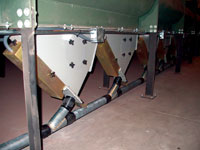 Contrarily, a
Contrarily, a 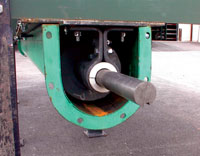 A final reason why the conveyor system is recommended in Total Containment Traps is safety. If a canister is allowed to overfill, the rounds will remain in the bullet trap and can potentially cause ricochet and/or clogging. Barrels can become filled with lead in as little as two weeks. The more the lead piles up, the bigger the safety issue. Range safety is critical and the screw conveyor system is the best choice for optimal safety.
A final reason why the conveyor system is recommended in Total Containment Traps is safety. If a canister is allowed to overfill, the rounds will remain in the bullet trap and can potentially cause ricochet and/or clogging. Barrels can become filled with lead in as little as two weeks. The more the lead piles up, the bigger the safety issue. Range safety is critical and the screw conveyor system is the best choice for optimal safety.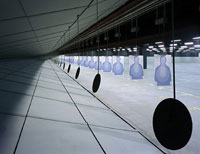 The Total Containment Trap is the dominant industry standard for modern, heavy-duty, steel bullet traps. It is the superior choice for ranges where safety, reliability, simple maintenance, and ease of use are top priorities. The TCT can be used both indoors and outdoors in all types of
The Total Containment Trap is the dominant industry standard for modern, heavy-duty, steel bullet traps. It is the superior choice for ranges where safety, reliability, simple maintenance, and ease of use are top priorities. The TCT can be used both indoors and outdoors in all types of  This is the same concept that is taking place when a bullet travels into the bullet trap. In front of the bullet there is a large wall of air that is being pushed into the trap. When a supersonic crack sounds, what is actually happening is that the bullet is breaking the shockwaves of air. This same air is what is being pushed in the bullet trap. If there were no dust collector on the bullet trap, the overpressure of the air entering the trap would collect surrounding particles and lead dust and shoot it back onto the range. This is where the dust collector becomes essential. The dust collector enables a negative pressure to be established inside the bullet trap, and it functions at a rate that is high enough to overcome the bullets and air pressure entering the trap. Referring again to the example of the cotton ball and the glass, if there was no back on the glass it would be easy to push the cotton ball to the rear of the glass by blowing on it. This is possible because there is no overpressure in the glass.
This is the same concept that is taking place when a bullet travels into the bullet trap. In front of the bullet there is a large wall of air that is being pushed into the trap. When a supersonic crack sounds, what is actually happening is that the bullet is breaking the shockwaves of air. This same air is what is being pushed in the bullet trap. If there were no dust collector on the bullet trap, the overpressure of the air entering the trap would collect surrounding particles and lead dust and shoot it back onto the range. This is where the dust collector becomes essential. The dust collector enables a negative pressure to be established inside the bullet trap, and it functions at a rate that is high enough to overcome the bullets and air pressure entering the trap. Referring again to the example of the cotton ball and the glass, if there was no back on the glass it would be easy to push the cotton ball to the rear of the glass by blowing on it. This is possible because there is no overpressure in the glass.